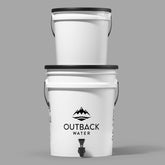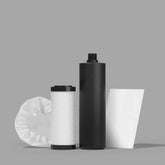Twenty Common Water Problems - Causes and Treatments
This is a simple general reference guide to identifying 20 common water problems. Many of these problems are more common in well water or surface water applications although some are found in municipal water supplies as well.
Please note that the following information is intended to be used as a general guide to help identify the cause of a water problem. Ultimately, a complete water analysis, performed by an accredited testing laboratory, may be required to accurately identify and confirm the cause of a water related problem.)
Problem 1: Water smells like rotten eggs.
Cause: Water may contain Hydrogen Sulfide gas (H2S). The problem can occur when water comes into contact with organic matter or with some minerals, such as pyrite.
Common Treatment: Chemical oxidation via manganese greensand filtration, chlorination, aeration or use of ozone, are common treatments for the removal of hydrogen sulfide.
Problem 2: Water smells like rotten eggs but testing shows the problem is NOT hydrogen sulfide (H2S).
Cause: Water conditions often fluctuate. Because of this, testing for Hydrogen Sulfide may show negative but the problem can still be caused by Hydrogen Sulfide. Because it is a gas, H2S its levels or concentration may fluctuate from day to day, based on the barometric pressure. Ultimately, if you are certain it is not Hydrogen Sulfide, the chances are good that the magnesium anode rod located in your hot water heater is causing the problem. This anode rod can react with your water and can cause a rotten egg smell.
Common Treatment: Replace the anode rod with a rod made from another type of material such as aluminum.
Problem 3: It is difficult to rinse the soap off when using soft water – skin feels slippery.
Cause: Hard water contains a higher concentration of calcium and magnesium ions than does soft water. When combined with soap, these hard water ions leave an insoluble soap-curd film (sometimes referred to as scum build-up) on your skin. This film causes a resistance causing your hair and skin to “squeak” when you are washing or bathing – thus the term “squeaky clean”. Soft water contains a lower concentration of calcium and magnesium ions and does not create this soap-curd or film. So, when you wash or bathe with soft water there is no layer of soap film accumulating on your skin and therefore there is little resistance – only smooth soft skin. The slippery feeling is not soap left behind but rather the absence of soap residue.
Treatment: There is no treatment necessary for water leaving the ‘slippery’ feel however water that leaves a soap-curd film can be treated with a water softener to reduce the hardness ions by reducing Calcium and Magnesium.
Problem 4: Brown staining on porcelain fixtures
Cause: High levels of iron in the water can result in brown staining on fixtures. The most likely source is a well which is fed via a ground water supply.
Common Treatment: Iron may be removed using an ion exchange water softener and/or a combination of the use of a water softener and the use of precipitation by chlorination with potassium permanganate.
Problem 5: Cloudy looking drinking water.
Cause: Cloudy or milky looking water is often the result of tiny air bubbles in the water. As with most bubbles, they rise to the surface and dissipate into the air, clearing the milky or cloudy appearance. The problem is generally caused by excess air in the water. This most commonly occurs when filters are replaced in drinking water systems or after a change or disruption in the main water source (where the line enters the home).
Common Treatment: The problem will generally correct itself within a short period of time as the excess air is depleted.
Problem 6: Black stains and pitting in stainless steel sinks and flatware.
Cause: The black staining could be caused by a very high concentration of chloride (CL-) in the water supply. When Chloride concentrations are high, the high drying temperatures in a dishwasher can accelerate the corrosion causing pitting in stainless utensils.
Common Treatment: Reverse osmosis or distillation.
Problem 7: Porcelain sinks and tubs have green stains and/or water has a blue-green hue.
Cause: A common cause of green staining is a high level of carbon dioxide (pH below 6.8) in the water reacting with brass and/or copper pipes.
Common Treatment: The pH can be neutralized by adding a calcite filter, by adding soda ash into the water with an injector feed pump, or by using a mixed media calcite/corsex filter.
Problem 8: Water is yellow in color (the color of tea).
Cause: Water may contain tannins (humic acid) found in harmless organic materials such as leaves or peat. This problem is typically found in surface water supplies such as lakes and streams.
Common Treatment: Tannins can be removed by chlorine or by adsorption using a selective macro porous Type 1 anion resin media.
Problem 9: Municipal water has a fishy taste.
Cause: Commonly caused by a residual of chloramines (chlorine and ammonia) in the water supply.
Common Treatment: Catalytic carbon
Problem 10: Clusters of blue baby syndrome, thyroid problems and stomach cancer.
Cause: These may be symptoms associated with excess nitrates (NO3-) in the drining water. Nitrates can cause “blue baby” syndrome or methemoglobinemia in infants which can be fatal. It hinders the ability of the bacteria in the baby’s intestine to allow the conversion and formation of nitrites from nitrates. Adults do not respond the same way as babies but, under the same conditions, may develop thyroid problems. In communities where the levels are greater than 100 mg/liter, stomach cancer can occur. The most common causes of high nitrate levels are pollution from sewage, from agricultural feed lots and corrals, from fertilized fields and industrial waste and from improperly sealed wells,
Common Treatment: Reverse osmosis, ion exchange unit with anion resin. NOTE: Boiling the water will INCREASE nitrate levels.
Problem 11: Water tastes as if it came from a swimming pool.
Cause: High chlorine levels in water supply.
Common Treatment: Coconut shell carbon filtration.
Problem 12: Minty odor in the water.
Cause: A minty odor can be caused by methyl tertiary butyl ether (MTBE), which is a gasoline additive used to oxygenate and raise the octane number. MTBE is a volatile, flammable and colorless liquid that is immiscible with water – it does not form a homogeneous mixture with water.
Common Treatment: Activated carbon adsorption.
Problem 13: Water has a distinct gritty feel and there is a residue in bathtub and sinks.
Cause: The grittiness can be caused from extremely fine sand or silt in the water supply. If the water is coming from a well the grit may be so fine it is bypassing any screens.
Common Treatment: Simple properly sized sediment filters.
Problem 14: Water has a salty taste.
Cause: Salty water may be caused either by high levels of sodium (NaCL, or NaSo4) or by magnesium (MgSO4). If you currently have a water softener installed it may be malfunctioning and introducing brine (salt) into the main water supply.
Common Treatment: Reverse osmosis, distillation or a call to the water softener repair person.
Problem 15: Water tastes like baking soda, aluminum pots and pans are stained.
Cause: One likely scenario is a high level of total dissolved solids (TDS) along with high alkalinity in the untreated water supply.
Common Treatment: Reverse osmosis
Problem 16: Water has a strong metallic taste.
Cause: A strong metallic taste can be caused by high iron content, may or may not be accompanied by staining on plumbing fixtures and porcelain tubs and sinks. Additionally it could be the result of very low pH (acidic) water – typically in the range of 4.5 to 5.5.
Common Treatment: Water softener or iron filter will remove iron. A calcite media filter can help to raise the pH.
Problem 17: A “BOIL WATER” alert is announced by your water provider or municipality because water is not suitable for human consumption (non-potable).
Cause: These alerts are generally caused by the presence of microbiological contamination. This can be confirmed by an accredited water testing laboratory.
Common Treatment: Long term correction requires treatment by UV, chlorination, distillation, ozone or physical filtration.
Problem 18: Water tests positive for E.coli
Cause: E. coli is a strain of bacteria found in the lower intestines of warm blooded organisms. The common causes are poor hygiene, well water contamination from run-off, or cross contamination with a septic system.
Common Treatment: UV, chlorination, distillation, ozone or physical filtration.
Problem 19: Water is suspected of containing cysts such as Cryptosporidium or Giardia lamblia.
Cause: Cysts are commonly found in unfiltered surface water. Transmission occurs by the fecal oral route. The organism is a protozoan and found in the environment as a dormant oocyst (pronounced oh-oh-cyst). Ingestion of the oocysts results in the disease Cryptosporidiosis, which can cause short term bouts of diarrheal illness in otherwise healthy people. Infected animals are the general source of contamination of a water supply.
Common Treatment: UV, ultra fine filtration of 1 micron or less.
Problem 20: Feeling ill after drinking rainwater from a collection barrel.
Cause: When rainwater first leaves the clouds it is as close to pure H2O as you can get. After that the story changes – as the rainwater picks up impurities during its fall and also during any contact with the rainwater collection method (roof, gutters, etc.). Further, rainwater is typically stored with no method of disinfection in moist dark areas, which are a perfect breeding ground for waterborne anaerobic microorganisms.
Common Treatment: UV light, chlorination, ozone, distillation and micro filtration.
- Choosing a selection results in a full page refresh.





